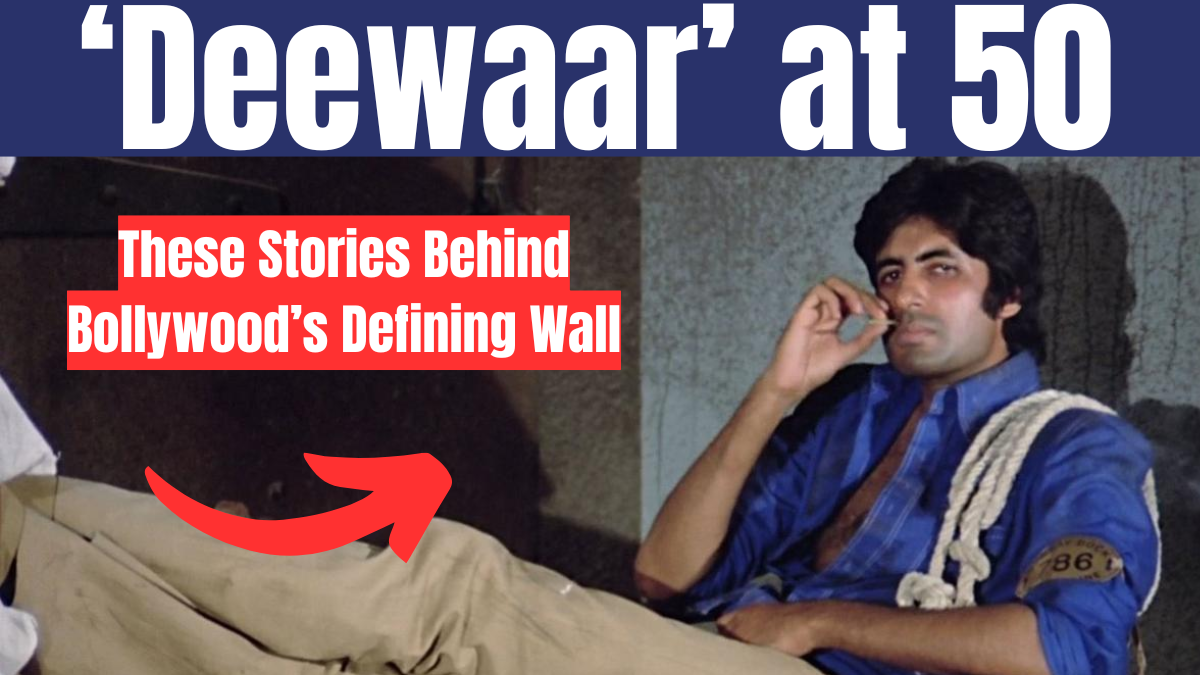Some films define a decade, but Deewaar defined an era. Released in 1975, Yash Chopra’s gritty crime drama revolutionized Bollywood storytelling, introducing a morally complex antihero in Amitabh Bachchan’s Vijay Verma. The film’s legacy is not just about its legendary dialogues but also about bold creative choices, industry-changing performances, and accidental yet iconic moments.
As Deewaar turns 50, let’s uncover the lesser-known stories that shaped this landmark film.

Which Actor Was Originally Considered for Vijay Verma?
It’s hard to imagine anyone other than Amitabh Bachchan as Vijay, but the role was first offered to Shatrughan Sinha.
At the time, Sinha was gaining popularity with his dialogue-heavy performances, but he ultimately turned down the part. Rajesh Khanna was also considered, but it was Bachchan, then struggling after a string of flops, who seized the opportunity. Deewaar didn’t just save his career—it cemented him as Bollywood’s “Angry Young Man”, a persona that would dominate Hindi cinema for years.
Why Was ‘Vijay’ Such an Important Name for Amitabh Bachchan?
If there was ever a name synonymous with Amitabh Bachchan, it was Vijay.
After Deewaar, Bachchan played a character named Vijay in over 20 films, including:
- Zanjeer (1973)
- Trishul (1978)
- Kaala Patthar (1979)
- Agneepath (1990)
The name became a cinematic shorthand for a brooding, rebellious hero who fought against fate and injustice. Whether by coincidence or industry superstition, writers repeatedly used Vijay for characters destined for greatness.
How Did a Costume Mistake Create an Iconic Look?
Vijay’s signature knotted denim shirt and rope sling weren’t part of a planned costume.
- The shirt was too long, so instead of cutting it, Bachchan tied it up, inadvertently creating a rugged, streetwise look.
- The rope was simply lying around on set. The team added it on a whim, and it became a defining visual motif.
What started as a costume fix turned into a fashion statement, with 70s men imitating Vijay’s tough, rebellious style.
Was the ‘Mera Baap Chor Hai’ Tattoo in the Original Script?
One of Deewaar’s most powerful images—Vijay’s forearm tattoo with the words “Mera Baap Chor Hai” (My Father is a Thief)—was not originally part of the screenplay.
The inspiration came from a real-life incident where a labor leader’s child was taunted with similar words. The addition gave Vijay a visual symbol of injustice and deep-seated anger, making it one of the most haunting elements of the film.
Did ‘Deewaar’ Have a Connection to Hong Kong Martial Arts Cinema?
While Bollywood action was still evolving, Deewaar drew inspiration from Hong Kong cinema, particularly the films of Bruce Lee.
- The dockyard fight sequence had a gritty, hand-to-hand combat style that mirrored the street fights in martial arts films.
- The action choreography blended Hong Kong-style intensity with Indian wrestling (pehelwani) techniques, making it a precursor to modern Bollywood action films.
Before wire-fu and CGI battles, Deewaar pioneered the realistic, raw fight scenes that became a Bollywood staple.
What’s the Story Behind Vijay’s 786 Badge?
Vijay’s badge numbered 786, gifted by Rahim Chacha, wasn’t just a random prop.
- In Islamic numerology, 786 symbolizes Bismillah (In the Name of God), representing divine protection.
- Throughout the film, as long as Vijay had the badge, he remained unharmed.
- The moment he loses it, his downfall begins, creating a subtle yet powerful layer of foreshadowing.
This seemingly minor detail became one of Bollywood’s most discussed symbolic elements.
How Did ‘Deewaar’ Inspire Indian Cinema Beyond Bollywood?
A film as powerful as Deewaar was bound to inspire remakes.
- Tamil Cinema: Thee (1981) starring Rajinikanth reimagined Vijay’s journey through a South Indian lens.
- Telugu Cinema: Magaadu (1976) adapted Deewaar’s themes for regional audiences.
- Malayalam Cinema: Naduvazhikal (1989) drew from Deewaar’s narrative structure.
The film’s universal themes of struggle, morality, and fate resonated across India’s diverse cinematic landscape.
Did ‘Deewaar’ Influence International Films?
Filmmakers around the world have acknowledged Deewaar’s influence.
- Danny Boyle, director of Slumdog Millionaire, called Deewaar “absolutely key to Indian cinema.”
- Deewaar inspired Hong Kong’s The Brothers, which later influenced John Woo’s A Better Tomorrow, laying the groundwork for the heroic bloodshed genre.
- The sibling conflict in Slumdog Millionaire mirrors Deewaar’s story of two brothers taking opposite paths.
Even outside Bollywood, Deewaar’s themes and visual storytelling continue to shape global cinema.
FAQs
Why is ‘Deewaar’ considered a landmark film in Bollywood?
Deewaar defined the “Angry Young Man” trope and revolutionized Bollywood by introducing morally complex protagonists, intense action, and hard-hitting dialogues.
Who was originally supposed to play Vijay in ‘Deewaar’?
The role was first offered to Shatrughan Sinha, and Rajesh Khanna was also considered before Amitabh Bachchan was cast.
What is the significance of Vijay’s ‘Mera Baap Chor Hai’ tattoo?
The tattoo was inspired by a real-life incident, serving as a visual representation of injustice and personal trauma in Vijay’s life.
What does the number 786 on Vijay’s badge mean?
In Islamic numerology, 786 represents Bismillah, symbolizing divine protection.
Was ‘Deewaar’ inspired by martial arts films?
Yes, the film’s fight sequences were influenced by Bruce Lee’s gritty action style, blending martial arts with Indian pehelwani techniques.
How did ‘Deewaar’ influence international cinema?
The film’s themes of fate, morality, and brotherhood inspired Hong Kong action films, Indian regional cinema, and even Hollywood narratives.
Click here to know more.
Aanchal is a passionate writer with a keen interest in storytelling, content creation, and creative expression. She enjoys exploring diverse topics and crafting engaging narratives that captivate readers.
